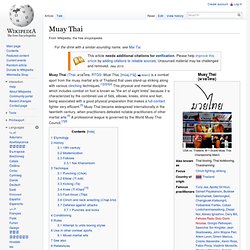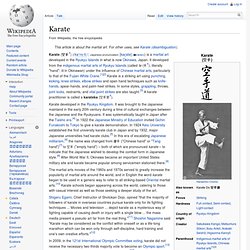

Choi Kwang-Do. Choi Kwang Do is a martial art developed by Kwang Jo Choi.

The style relies more on flexibility and fluidity of movement as opposed to the more rigid lines of some other martial arts. To achieve this it employs yoga-based stretching to develop the flexibility of practitioners.[1] History[edit] Choi Kwang Do was founded by Kwang Jo Choi on March 2, 1987. Kwang Jo Choi was born in South Korea before emigrating to Canada in the early 1970s.[2] Choi was a successful ITF Tae Kwon Do practitioner and trainer (serving as a chief instructor) before establishing his own style.[3] Style and training[edit] Choi Kwang Do is not designed for competition,[7] but for a natural and effective response to everyday stimuli and training is a mix of contact drills using pads and shields, non-contact drills and "in-fighting" close-quarter drills.[8] Practitioners[edit] Notable practitioners of the Choi Kwang Do style include:
Muay Thai. Muay Thai (Thai: มวยไทย, RTGS: Muai Thai, [mūaj.tʰāj] ( )) is a combat sport from the muay martial arts of Thailand that uses stand-up striking along with various clinching techniques.[1][2][3][4] This physical and mental discipline which includes combat on foot is known as "the art of eight limbs" because it is characterized by the combined use of fists, elbows, knees, shins and feet, being associated with a good physical preparation that makes a full-contact fighter very efficient.[5] Muay Thai became widespread internationally in the twentieth century, when practitioners defeated notable practitioners of other martial arts.[6] A professional league is governed by the World Muay Thai Council.[7][8] Etymology[edit] The word Muay derives from the Sanskrit Mavya which means "to bind together".

History[edit] Praying before the match Muay Thai championship boxing match in Sterling, VA 19th century[edit] Modernization[edit] Today, there are thousands of gyms spread out across the globe. Karate. Karate (空手?)

(/kəˈrɑːtiː/; Japanese pronunciation: [kaɽate] ( Karate developed in the Ryukyu Kingdom. It was brought to the Japanese mainland in the early 20th century during a time of cultural exchanges between the Japanese and the Ryukyuans. It was systematically taught in Japan after the Taisho era.[4] In 1922 the Japanese Ministry of Education invited Gichin Funakoshi to Tokyo to give a karate demonstration. In 1924 Keio University established the first university karate club in Japan and by 1932, major Japanese universities had karate clubs.[5] In this era of escalating Japanese militarism,[6] the name was changed from 唐手 ("Chinese hand" or "Tang hand")[7] to 空手 ("empty hand") – both of which are pronounced karate – to indicate that the Japanese wished to develop the combat form in Japanese style.[8] After World War II, Okinawa became an important United States military site and karate became popular among servicemen stationed there.[9]